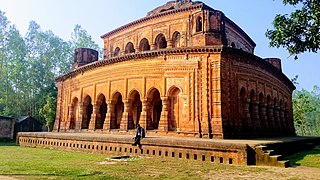
Rajshahi Division is one of the eight first-level administrative divisions of Bangladesh. It has an area of 18,174.4 square kilometres (7,017.2 sq mi) and a population at the 2022 Census of 20,353,119. Rajshahi Division consists of 8 districts, 70 Upazilas and 1,092 Unions.

Chandra Shekhar Sitaram Tiwari, popularly known as Chandra Shekhar Azad, was an Indian revolutionary who reorganised the Hindustan Republican Association (HRA) under its new name of Hindustan Socialist Republican Association (HSRA) after the death of its founder, Ram Prasad Bismil, and three other prominent party leaders, Roshan Singh, Rajendra Nath Lahiri and Ashfaqulla Khan. He hailed from Bardarka village in Unnao district of United Provinces and his parents were Sitaram Tiwari and Jagrani Devi. He often used the pseudonym "Balraj" while signing pamphlets issued as the commander-in-chief of the HSRA.

Sirajganj District is a district in the North Bengal region of Bangladesh, located in the Rajshahi Division. It is the 25th largest district by area and 9th largest district by population in Bangladesh. It is known as the gateway to North Bengal.

The Bengal Renaissance, also known as the Bengali Renaissance, was a cultural, social, intellectual, and artistic movement that took place in the Bengal region of the British Raj, from the late 18th century to the early 20th century. Historians have traced the beginnings of the movement to the victory of the British East India Company at the 1757 Battle of Plassey, as well as the works of reformer Raja Rammohan Roy, considered the "Father of the Bengal Renaissance," born in 1772. Nitish Sengupta stated that the movement "can be said to have … ended with Rabindranath Tagore," Asia's first Nobel laureate.

North Bengal or Uttar Banga is a term used for the north-western part of Bangladesh and northern part of West Bengal. The Bangladesh part denotes the Rajshahi Division and Rangpur Division. Generally, it is the area lying west of Jamuna River and north of Padma River and includes the Barind Tract. The West Bengal part denotes Jalpaiguri Division and the Malda division together. The Bihar parts include the Kishanganj district. It also includes parts of Darjeeling Hills. Traditionally, the Ganga River divides Bengal into South Bengal and North Bengal, divided again into Terai and Dooars regions. Jalpesh and jatileswar are some of the most popular sacred places.

Sirajganj is a city in north-western Bangladesh on the right bank of the Jamuna River, located in Rajshahi Division. It is the administrative headquarters of Sirajganj District, and with a population of 450,000 is the 12th largest city in Bangladesh.

Ram Prasad Bismil was an Indian poet, writer, and revolutionary who fought against British Raj, participating in the Mainpuri Conspiracy of 1918, and the Kakori Conspiracy of 1925. He composed in Urdu and Hindi under pen names Ram, Agyat and Bismil, becoming widely known under the latter. He was also a translator.

Bappi Aparesh Lahiri, also known as Bappida was an Indian singer, composer and record producer. He popularised the use of synthesised disco music in Indian music industry and sang some of his own compositions. He was popular in the 1980s and 1990s with filmi soundtracks. He also delivered major box office successes in Bengali, Telugu, and Kannada films. His music was well received into the 21st century.
The Revolutionary movement for Indian Independence was part of the Indian independence movement comprising the actions of violent underground revolutionary factions. Groups believing in armed revolution against the ruling British fall into this category, as opposed to the generally peaceful civil disobedience movement spearheaded by Mahatma Gandhi.

Bhavabhushan Mitra, or Bhaba Bhusan Mitter, alias Swami Satyananda Puri was a Bengali Indian freedom fighter and an influential social worker.

The Kakori Train robbery was a train robbery that took place at Kakori, a village near Lucknow, on 9 August 1925, during the Indian independence movement against the British rule in India. It was organized by the Indian revolutionaries of Hindustan Republican Association (HRA).

Ashfaqulla Khan was freedom fighter in the Indian independence movement against British rule and co-founder of the Hindustan Republican Association, later to become the Hindustan Socialist Republican Association.

Rajendra Nath Lahiri, known simply as Rajendra Lahiri, was an Indian revolutionary, who was a mastermind behind the Kakori conspiracy and Dakshineshwar bombing. He was active member of Hindustan Republican Association aimed at ousting the British from India.

Ullapara is an upazila, or sub-district of Sirajganj District, located in Rajshahi Division, Bangladesh.

Jatindra Mohan Sengupta was an Indian revolutionary against the British rule. He was arrested several times by the British police. In 1933, he died in a prison located in Ranchi, India.

Sirajganj-5 is a constituency represented in the Jatiya Sangsad of Bangladesh since 2024 by Abdul Momin Mondol of the Awami League.

Sirajganj-2 is a constituency represented in the Jatiya Sangsad of Bangladesh since 2024 by Dr.Jannat Ara Henry of the Awami League.

Sirajganj-1 is a constituency represented in the Jatiya Sangsad of Bangladesh since 2024 by Tanvir Shakil Joy of the Awami League.
Communists were actively involved in Indian independence movement through multiple series of protests, strikes and other activities. It was a part of revolutionary movement for Indian independence. Their main thrust was on organising peasants and working classes across India against the British and Indian capitalists and landlords.
Gopal Chandra Lahiri (1858-1936) was a feudal lord and pioneer of education in Northern Bengal. He was the founder of Edward College in Pabna.















